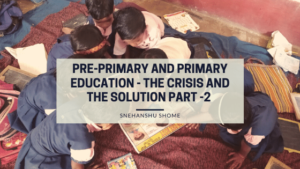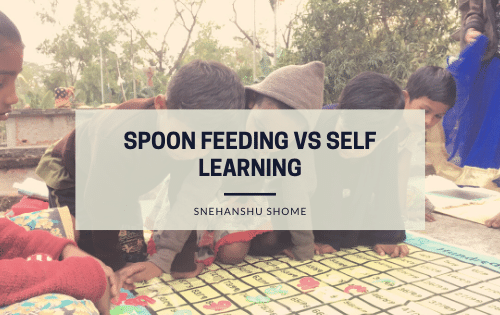The monograph (Part 1 and 2) explores the Education system in India as it has come through over the years and the various policies and schemes taken up by the government for the improvement of this system. It also mentions the data points collected by various government and non-government agencies which brings out the crisis that the country is facing in the education sector. There are a number of steps taken up by the government over the years to solve this while a lot of organizations in the non-profit sector have also played a major role in that. The monograph talks about them and the National Education Policy 2019 and the effect that it can create in all of this.
Education has always been one of the bigger challenges the country has been facing for a long time. In India, education has come a long way since the ancient times, falling apart of that system after the colonial rule began and the implementation of a new and foreign system over it. Education thus has remained a luxury for the most part of the early 1900s controlled by the Britishers, only the really privileged class had access to it. The late 1900s, post-independence education has always remained among the government’s focusses and a lot of work has been done to improve the condition of Education and educational infrastructures, the framing of policies and laws, making Education a fundamental right has definitely led to much improvement. Yet a lot of work is yet still required.
The first program that was developed majorly for Education was the District Primary Education Program (DPEP). The objective of the program was to universalise primary education. It went on to create several educational infrastructures all over the country and was a huge success. One of the other pioneering programs was the Sarva Shiksha Abhiyan which focussed on the age group 6-14 years old and the ways to uplift their educational status. Much emphasis was given during this period to make changes to the way things were running for the primary or “Elementary” Education. A subprogram within it Padhe Bharat, Bade Bharat was launched to improve comprehensive reading, writing, and mathematical skills of children from classes 1 and 2.
“In its Millennium Development Goals (MDG) assessment in 2015, UNDP stated that India has made significant progress in universalizing primary education, and is moderately on track to achieve this goal. Enrolment and completion rates of girls in primary school have improved and are catching up with those of boys, as are elementary completion rates.
However, UNDP cautions about the large numbers of children still out of school and failing to complete primary education.”
Even with a number of steps taken by the government, there is a huge difference between the figures and the reality of the situation. The reality of the situation is that schools across the country especially in the rural areas are facing a major learning crisis. Across India, less than 45% of children in Grade 5 are of Grade 2 or less while 25 Million students fail to cope up with their classes and suffer from severe learning deficiencies. There are several factors that have led to these figures but it can be broadly identified into – gaps in the curriculum, unavailability of teachers, not enough infrastructure, and problems with the implementation of the whole educational program. There is a severe gap in curriculum especially in the primary grade that has been affecting the whole system.
The curriculum for the primary grade starts with mostly all the subjects at once, for a child who is in class 1, there is a time limit to learn and start writing and to perform in the tests. Usually writing and learning alphabets of any language or a simple number and mathematical understanding takes a lot of time. If this process does not start at home or in any pre-school facility, a kid taking direct admission in class 1 is at a serious disadvantage. The result is that this disadvantage travels with him as he moves ahead in the curriculum and in classes. With a no-detention policy till class 8, it is common within the kids especially from an underprivileged background with a lack of good educational facility to show signs of severe learning deficiencies even when he is in a much higher class. In India right now the dropout rate shoots from 4% in primary to 17% in secondary in India right now. Out of the many things, it also indicates that the severe learning deficiencies obtained during primary education stay on and only grow as kids move into secondary grades. The lack of secondary schools in India is also a big factor for it though.
There has been a number of intervention programs run by the government and by organizations all over the country to help tackle this problem. The Saksham Goshna program in Haryana had the goal to diagnose the learning level in the government schools and increase the proficiency of children in Hindi and Mathematics. It is an interesting concept where there is a competitive spirit between the different blocks of the state to become ‘Saksham’. A block becomes ‘Saksham when 80% of the children are on their grade level. Nearly 68 blocks from 21 districts have claimed this status for themselves in Haryana. The Odisha Primary Education Programme Authority had two programs Ujjwal and Utthan to facilitate a similar action under the Learning Enhancement Programme. Both the programs collectively work for children from Grade 1st to 8th. It is a special curriculum designed especially as a 40 days camp to help children who are behind their grade level.
The major problem with programs that are implemented by the government is the lack of human resources. In some of the rural and remote areas where the schools are understaffed, teachers are already overburdened with teaching kids, school management work, and all other governmental work that they are assigned to year-round including for elections and surveys. Any new program implemented on the teachers, even if it is a training provided to them for a new curriculum or a new system to organize the classroom, adds up to already existing work and teachers often have not much motivation left to implement these. Even if the system reaches the classroom, there is hardly any mechanism there to monitor the whole system from urban to rural areas as a whole. In this case, it might be better to implement such programs with a private partner.
Pratham, one of the largest NGOs in India has been doing significant work for this. Pratham works for the provision of quality education to underprivileged children in India. With the ASER(Annual Survey of Education Report), Pratham’s one of the models works on improving the learning outcomes of students by teaching them according to their level by first finding out their own levels using the ASER test. Once the levels have been identified then they are taught according to it. Before working on the model on a large scale, several randomized controlled trials were conducted to find out the right approach in implementing the “Teaching at the Right Level” Methodology. Pratham is currently working in over 23 states and has brought about a significant change with the help of governmental agencies.
The draft National Education Policy 2019 provides insight into categories of students who are covered under the education policies of the government. An interesting perspective is a focus on Early Childhood Care and Education. The NEP provides greater insight into the importance, crisis, and several solutions for ECCE. The NEP in detail talks about the situation of Anganwadis in the country. It’s brutally honest about the fact that even if Anganwadis may have contributed significantly to improving health care but it lags behind in the educational side. It also talks about the fact that 3-6 years, an age group not given much focus before, is a very important part of the education. The move to incorporate pre-primary education into the already existing schooling system can be a major boost to the present scenario.
References
- https://www.povertyactionlab.org/case-study/teaching-right-level-improve-learning
- https://en.wikipedia.org/wiki/Sarva_Shiksha_Abhiyan
- https://archive.india.gov.in/sectors/education/index.php?id=14
- https://www.oxfamindia.org/featuredstories/indias-missing-millions-out-school-children-case-reality-not-living-estimation
- https://www.graymatters.in/saksham-haryana
- https://timesofindia.indiatimes.com/city/chandigarh/over-80-schools-in-punjab-now-saksham/articleshow/68211050.cms
- https://www.livemint.com/Education/k1ANVHwheaCFWCupY3jkFP/Trends-in-school-enrolment-and-dropout-levels.html
- https://leadsplus.wordpress.com/2019/02/12/learning-enhancement-programme-lep-2019-understanding-about-ujjwal-and-utthan/
- https://www.livemint.com/Opinion/oZw3aIX99bMUEVV3ycPTPJ/Working-together-to-teach-at-the-right-level.html


